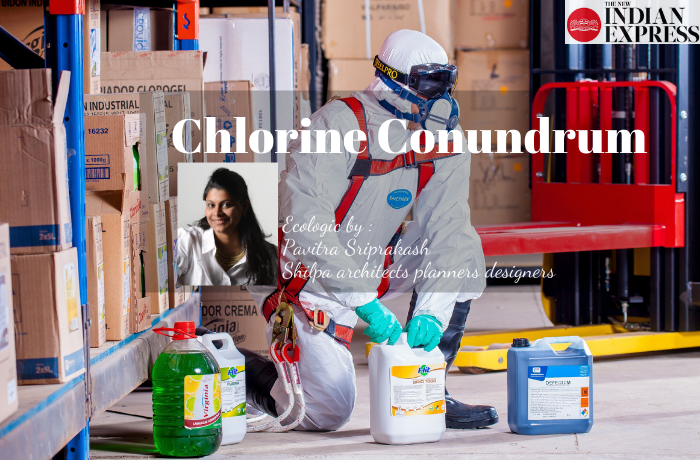Chlorine Conundrum
Have you noticed the white bleach powder added around all local garbage dumps lately? Every morning, a generous amount of white bleach powder is sprinkled by a Corporation worker around the garbage bins in the city with the aim of sanitizing the area around it and keeping it free from germs and bacteria. While keeping an area clean is a commendable task, we need to find the right way to achieve this without hurting or affecting the environment that surrounds these bins.
There is also a thought that this may deter animals from going through the garbage bins — but with the large amounts of unsegregated garbage being dumped in these bins, it is going to continue attracting strays in-spite of the bleach on the ground. This will further cause health issues and often death for these animals due to the levels of toxins that build up. The active ingredient in bleach is Chlorine. Also found in other cleaning products like scrubbing powders, toilet cleaners and laundry whiteners, Chlorine is almost always added to the water supply and in swimming pools to keep it clean. Just a simple Google search puts out many links on the adverse effects on chlorine on human health and it is just because there are so many avenues of exposure with this toxin.
You could be inhaling fumes and possibly through skin when you come in contact with it during cleaning. In our cities, it in injected in the form of gas into the water prior to supply in order to get rid of bacteria and keep the water smelling clean. Even though these are checked by health officials and certified as safe, we are still getting exposed to the chemical when taking a shower or bathe. The health risks from chlorine can be acute, and they can be chronic — it’s a respiratory irritant at an acute level. But the chronic effects are what people are unaware of — it may be a serious thyroid disrupter and a carcinogen.
There are several non-toxic alternatives to bleach that are easily available depending on the usage in homes and daily cleaning routines. Bleach in laundry can be easily replaced with vinegar by creating an overnight soak of clothes in a vinegar solution and then running a regular wash on the clothes. Baking soda is yet another popular substitute to bleach for laundry. Baking soda also works very well in the cleaning of dishware and baked-on stains. It is an effective deodorant for our homes as well. However, the real winning combination is that of baking soda and vinegar.
When combined we have a cheap, simple and very effective cleaner/deodorizer that can cut through even the dirtiest parts of a toilet. Baking soda is excellent to remove any staining and the vinegar has antiseptic and disinfectant properties. This combination also neutralises odours and is very safe for both humans and our environment.
On a city scale, there is sufficient research and development on systems of disinfection of water through alternative processes such as UV irradiation and membrane systems. Though there are still many challenges in making these widely available, it is time for us to consider switching to a non-Chlorine option for our daily potable supply. As for the bleach around garbage bins — let’s be smart, segregate and not have waste that turns to maggots or attracts hungry animals.



